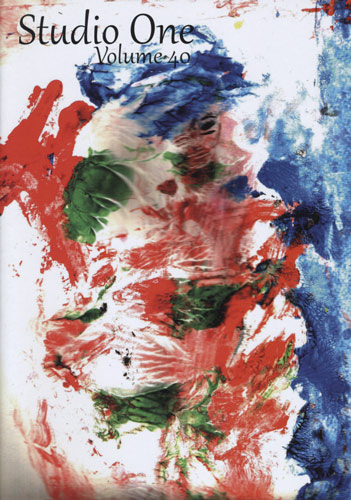Studio One – 2015
A lot of originality is packed into a smart little anthology called Studio One. Take a look at the bright cover art, “Old Lady with the Black Eye” by multi-talented Ernest Williamson, greeting readers. Williamson has an additional painting within the volume, “Artist Delving into Her Craft,” which on the one hand I can’t quite figure out, and on the other hand I find impossible to stop looking at. Also outstanding is a portfolio of five luminous scenes by Colorado photographer Rita Thomas. “Pixie Forest,” which appears to be frost-covered trees by moonlight, is most stunning. A lot of originality is packed into a smart little anthology called Studio One. Take a look at the bright cover art, “Old Lady with the Black Eye” by multi-talented Ernest Williamson, greeting readers. Williamson has an additional painting within the volume, “Artist Delving into Her Craft,” which on the one hand I can’t quite figure out, and on the other hand I find impossible to stop looking at. Also outstanding is a portfolio of five luminous scenes by Colorado photographer Rita Thomas. “Pixie Forest,” which appears to be frost-covered trees by moonlight, is most stunning.
Studio One is the product of the College of St. Benedict and St. John’s University, partnered liberal arts colleges in Minnesota. Since 1987, the magazine has awarded an annual prize for excellence in creative writing to a student at the College of St. Benedict. This year’s recipient is Marissa Deml, and her short story is titled “Later.” Deml’s character, Milly, has snapshot visions of past and hoped-for future events while she counts down the minutes and keeps us waiting for results of her pregnancy test. Placed at the end of the issue, Deml’s story provides solid closure.
“Foolish,” an essay by College of St. Benedict student Bailey Zallek, also keeps us waiting while she recounts, as a 14-year-old, being called out of class and confronted by a police officer. “For the first time in my short little life, I’m at a loss for words. I’ve always been a good kid—a chronic perfectionist, in fact, with an arguably unhealthy straight-A addiction.” The only other prose piece this year is “On the Town” by St. John’s University student Cole Minkel, about a lonely, confused young man.
Most of Studio One is devoted to poetry. I was impressed by Judith Levison’s powerful “Masterpiece Theater” about the bittersweet turns of love:
At the dinner table you slowly
Moved my chair in as if I were a child
Such charm was ether
My worries fell like petals at my feet
The man in question is later asked to bring her zebra slippers to the hospital after she undergoes chemo. “You said there had been a glitch at work / Tired, Masterpiece Theater was on / I knew then I could leave you.”
Another love—or rather love lost—poem is Bruce Bagnell’s “Peeling.” The woman leaves a ten-year relationship, and so the man paints over cat scratches and food stains:
and after the last brush strokes,
I will peel the masking tape,
[ . . . ] sticky in my hand before I shake free of it,
the house’s memory erased,
but not mine.
New Yorker Susan H. Maurer switches the mood with “The Polar Vortex.” Great for this time of year, it starts off, “Chianophobia means / fear of snow. I try / to imagine it and don’t / quite get there.” Another fitting winter poem is Richard Dinges, Jr.’s “Back Home,” in which he shows us:
stores crowded
with muffled people
looking for something
to fill their mouths,
clog their arteries,
and explain why
vacation is somewhere
we escape to come
home to all this
frozen mystery.
But the poem “Hush” by College of St. Benedict student Emily Schoenbeck, gets my vote for absolute best creative technique as she leads off with images of lullabies and giving birth, then suddenly envelops the reader into an altogether different scenario.
Studio One is an excellent combination of student and non-student works that can be read in a sitting, but calls for a return visit to cull even more meaning from these carefully composed pieces. If I were forced to find fault with anything in this volume, it would be that it’s too short.
[www.digitalcommons.csbsju.edu/studio_one]





